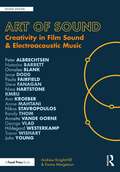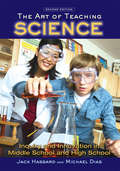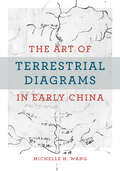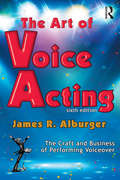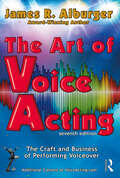- Table View
- List View
The Art of Safety Auditing: A Tutorial for Regulators
by Sasho AndonovThe Art of Safety Auditing: A Tutorial for Regulators provides the theory and practice of auditing safety management systems implemented by the companies in risk industries. With his extensive knowledge and experiences in quality and safety, Sasho Andonov provides the tools to fill the gap in regulatory auditing for safety management systems. The book explains in detail the overall process of auditing with emphasis on practical execution of audits by Safety Regulators in each State or International Organizations. This book presents real examples and outlines every aspect of regulations and oversight audits in high risk industries. FEATURES Offers all theoretical and practical aspects of safety audits Dedicated to regulatory bodies and companies in high risk industries Provides a holistic approach to auditing as part of regulatory oversight activities Discusses most common mistakes during audits and advices how to correct them Excellent tool for auditors and safety managers, but can be utilized in other industries
The Art of Safety Auditing: A Tutorial for Regulators
by Sasho AndonovThe Art of Safety Auditing: A Tutorial for Regulators provides the theory and practice of auditing safety management systems implemented by the companies in risk industries. With his extensive knowledge and experiences in quality and safety, Sasho Andonov provides the tools to fill the gap in regulatory auditing for safety management systems. The book explains in detail the overall process of auditing with emphasis on practical execution of audits by Safety Regulators in each State or International Organizations. This book presents real examples and outlines every aspect of regulations and oversight audits in high risk industries. FEATURES Offers all theoretical and practical aspects of safety audits Dedicated to regulatory bodies and companies in high risk industries Provides a holistic approach to auditing as part of regulatory oversight activities Discusses most common mistakes during audits and advices how to correct them Excellent tool for auditors and safety managers, but can be utilized in other industries
The Art of Software Thermal Management for Embedded Systems
by Mark BensonThis book introduces Software Thermal Management (STM) as a means of reducing power consumption in a computing system in order to manage heat, improve component reliability and increase system safety. Readers will benefit from this pragmatic guide to the field of STM for embedded systems and its catalog of software power management techniques. Since thermal management is a key bottleneck in embedded systems design, this book focuses on root cause of heat in embedded systems: power. Since software has an enormous impact on power consumption in an embedded system, this book urges software engineers to manage heat effectively by understanding, categorizing and developing new ways to reduce static and dynamic power consumption. Whereas most books on thermal management describe mechanisms to remove heat, this book focuses on ways for software engineers to avoid generating heat in the first place.
Art of Sound: Creativity in Film Sound and Electroacoustic Music (Sound Design)
by Andrew Knight-Hill Emma MargetsonBringing together a diverse group of world leading professionals across Post-Production Film Sound and Electroacoustic Music, Art of Sound explores the creative principles that underpin how sonic practitioners act to compose, tell stories, make us feel, and communicate via sound. Revealing new understandings through analysis of interdisciplinary exchanges and interviews, this book investigates questions of aesthetics, perception, and interpretation, unveiling opportunities for a greater appreciation of the artistry in sound practice which underpins both experimental electronic music and the world’s leading film and television productions. It argues that we can better understand and appreciate the creative act if we regard it as a constantly unfolding process of inspiration, material action, and reflection. In contrast to traditional notions, which imagine outputs as developed to reflect a preconceived creative vision, our approach recognises that the output is always emerging as the practitioner flows with their materials in search of their solution, constantly negotiating the rich networks of potential. This enables us to better celebrate the reality of the creative process, de-centring technologies and universal rules, and potentially opening up the ways in which we think about sonic practices to embrace more diverse ideas and approaches. Art of Sound provides insight into the latest developments and approaches to sound and image practice for composers, filmmakers, directors, scholars, producers, sound designers, sound editors, sound mixers, and students who are interested in understanding the creative potential of sound.
Art of Sound: Creativity in Film Sound and Electroacoustic Music (Sound Design)
by Andrew Knight-Hill Emma MargetsonBringing together a diverse group of world leading professionals across Post-Production Film Sound and Electroacoustic Music, Art of Sound explores the creative principles that underpin how sonic practitioners act to compose, tell stories, make us feel, and communicate via sound. Revealing new understandings through analysis of interdisciplinary exchanges and interviews, this book investigates questions of aesthetics, perception, and interpretation, unveiling opportunities for a greater appreciation of the artistry in sound practice which underpins both experimental electronic music and the world’s leading film and television productions. It argues that we can better understand and appreciate the creative act if we regard it as a constantly unfolding process of inspiration, material action, and reflection. In contrast to traditional notions, which imagine outputs as developed to reflect a preconceived creative vision, our approach recognises that the output is always emerging as the practitioner flows with their materials in search of their solution, constantly negotiating the rich networks of potential. This enables us to better celebrate the reality of the creative process, de-centring technologies and universal rules, and potentially opening up the ways in which we think about sonic practices to embrace more diverse ideas and approaches. Art of Sound provides insight into the latest developments and approaches to sound and image practice for composers, filmmakers, directors, scholars, producers, sound designers, sound editors, sound mixers, and students who are interested in understanding the creative potential of sound.
The Art of Sound Reproduction
by John WatkinsonDesigned to make life a little easier by providing all the theoretical background necessary to understand sound reproduction, backed up with practical examples. Specialist terms - both musical and physical - are defined as they occur and plain English is used throughout. Analog and digital audio are considered as alternatives, and the advantages of both are stressed. Audio is only as good as the transducers employed, and consequently microphone and loudspeaker technology also feature heavily - making this the most comprehensive, up-to-date text currently available on all aspects of sound reproduction.
The Art of Sound Reproduction
by John WatkinsonDesigned to make life a little easier by providing all the theoretical background necessary to understand sound reproduction, backed up with practical examples. Specialist terms - both musical and physical - are defined as they occur and plain English is used throughout. Analog and digital audio are considered as alternatives, and the advantages of both are stressed. Audio is only as good as the transducers employed, and consequently microphone and loudspeaker technology also feature heavily - making this the most comprehensive, up-to-date text currently available on all aspects of sound reproduction.
The Art of Systems Architecting (Systems Engineering Ser.)
by Mark W. MaierIf engineering is the art and science of technical problem solving, systems architecting happens when you don't yet know what the problem is. The third edition of a highly respected bestseller, The Art of Systems Architecting provides in-depth coverage of the least understood part of systems design: moving from a vague concept and limited resources
The Art of Taxidermy
by Jane EastoeThe Art of Taxidermy is a contemporary look at an historical and controversial subject – a sumptuous photographic led exploration of the genre's history, uses and modern applications. Taxidermy courses are enjoying a renewed surge of popularity and this book is poised to offer the new wave of enthusiasts a beautiful volume on the subject.
The Art of Teaching Physics with Ancient Chinese Science and Technology (Synthesis Lectures on Engineering, Science, and Technology)
by Matt MaroneBlending physics with the study of ancient Chinese science, technology, and culture is a unique and highly effective way to present the fundamentals of physics to non-science majors. Based on the author’s course at Mercer University (Georgia, U.S.), The Art of Teaching Physics with Ancient Chinese Science and Technology exposes a wide range of students to the scientific method and techniques of experimental analysis through the eyes and discoveries of ancient Chinese “polymaths” long before the European concept of the scientific method was even considered. No other book so deftly makes the connections from ancient China to Ben Franklin to Michael Faraday while teaching physics at the same time. A distinctive characteristic of this book is the detailed hands-on laboratory experiments. This first includes making a simple magnetic compass and magnetometer. Students then use the compass/magnetometer to measure the strength of the magnetic field produced by a long straight wire. The second experiment covers two different methods of mining copper to introduce students to simple chemical principles such as displacement reactions, oxidation, reduction, and electronegativity. Originally developed for non-science students in an Asian studies environment, this book provides a valuable resource for science teachers who wish to explore the historical connections largely ignored in traditional texts. When paired with Teaching Physics through Ancient Chinese Science and Technology (Marone, 2019), these two texts provide a unique means of studying selected topics traditionally found in a two-semester Physics course.
The Art of Teaching Primary School Science
by Vaille Dawson Grady VenvilleThe long-awaited second edition of The Art of Teaching Primary School Science has evolved to meet the demands of schools in our rapidly changing society. Recognising that children have an innate curiosity about the natural world means that teaching primary school science is both rewarding and critical to their futures. The focus of the chapters reflects the deep expertise in curriculum and pedagogy of the chapter authors. Included are chapters on the nature (wonder) of science and how children learn as well as the nuts and bolts of teaching: planning, pedagogy and assessment. In addressing the teacher education AITSL professional standards for teaching, there are chapters on digital pedagogies, differentiation and advanced pedagogies such as problem-based learning. Finally, there is a section on STEM education that explains how an integrated approach can be planned, taught and assessed. This book is both accessible to all preservice and practising teachers and up-to-date in providing the right mix of theoretical and practical knowledge expected of this generation of primary school teachers. Teacher educators worldwide will find this an essential resource.
The Art of Teaching Primary School Science
by Vaille Dawson Grady VenvilleThe long-awaited second edition of The Art of Teaching Primary School Science has evolved to meet the demands of schools in our rapidly changing society. Recognising that children have an innate curiosity about the natural world means that teaching primary school science is both rewarding and critical to their futures. The focus of the chapters reflects the deep expertise in curriculum and pedagogy of the chapter authors. Included are chapters on the nature (wonder) of science and how children learn as well as the nuts and bolts of teaching: planning, pedagogy and assessment. In addressing the teacher education AITSL professional standards for teaching, there are chapters on digital pedagogies, differentiation and advanced pedagogies such as problem-based learning. Finally, there is a section on STEM education that explains how an integrated approach can be planned, taught and assessed. This book is both accessible to all preservice and practising teachers and up-to-date in providing the right mix of theoretical and practical knowledge expected of this generation of primary school teachers. Teacher educators worldwide will find this an essential resource.
Art of Teaching Primary Science
by Vaille Dawson Grady VenvilleChildren have an innate curiosity about the natural world that makes teaching science a rewarding experience.However teaching science is an art that requires a unique combination of knowledge and skills to make the most of students' interest and foster their understanding. With contributions from leading educators, The Art of Teaching Primary Science addresses the fundamental issues in teaching science in primary and early childhood years.Reflecting current research in science education, The Art of Teaching Primary Science covers the following areas:* the theoretical underpinnings of science education and curriculum;* effective science teaching practice planning, teaching strategies, investigations, resources and assessment;* key issues including scientific literacy, integrating science and technology, and activities outside the classroom.The Art of Teaching Primary Science is invaluable for student teachers as a guide to the fundamentals of science education, and as a resource for experienced teachers to review and enhance their professional skills.'An excellent reference for those teachers of the primary years seeking the best ways to engage their students in good science and scientific investigation, and keen to link these with other learning areas.'Peter Turnbull, President, Australian Science Teachers Association
Art of Teaching Primary Science
by Vaille Dawson Grady VenvilleChildren have an innate curiosity about the natural world that makes teaching science a rewarding experience.However teaching science is an art that requires a unique combination of knowledge and skills to make the most of students' interest and foster their understanding. With contributions from leading educators, The Art of Teaching Primary Science addresses the fundamental issues in teaching science in primary and early childhood years.Reflecting current research in science education, The Art of Teaching Primary Science covers the following areas:* the theoretical underpinnings of science education and curriculum;* effective science teaching practice planning, teaching strategies, investigations, resources and assessment;* key issues including scientific literacy, integrating science and technology, and activities outside the classroom.The Art of Teaching Primary Science is invaluable for student teachers as a guide to the fundamentals of science education, and as a resource for experienced teachers to review and enhance their professional skills.'An excellent reference for those teachers of the primary years seeking the best ways to engage their students in good science and scientific investigation, and keen to link these with other learning areas.'Peter Turnbull, President, Australian Science Teachers Association
The Art of Teaching Science: A comprehensive guide to the teaching of secondary school science
by Vaille Dawson Grady Venville Jennifer DonovanThe Art of Teaching Science has proven itself to be one of the most popular introductory texts for Australian pre-service and in-service teachers, providing guidance on engaging students and helping develop scientifically literate citizens. Beginning with an examination of the nature of science, constructivist and socio-cultural views of teaching and learning and contemporary science curricula in Australian schools, the expert authors go on to explore effective teaching and learning strategies, approaches to assessment and provide advice on the use of ICT in the classroom. Fully revised and updated, this edition also reflects the introduction of the AITSL professional standards for teachers and integrates them throughout the text. New chapters explore: •a range of teaching strategies including explicit instruction, active learning and problem-based learning; •the effective integration of STEM in schools; •approaches to differentiation in science education; and•contemporary uses of ICT to improve student learning. Those new to this text will find it is deliberately written in user-friendly language. Each chapter stands alone, but collectively they form a coherent picture of the art (in the sense of creative craft) and science (as in possessing the knowledge, understanding and skills) required to effectively teach secondary school science. 'Helping each new generation of school science teachers as they begin their careers is crucial to education. This is the updated, third edition of this valuable textbook. It contains a wonderful range of inspirational chapters. All science teachers, not only those at the start of the profession, would benefit from it, in Australia and beyond.'Michael J. Reiss, Professor of Science Education, University College, London
The Art of Teaching Science: A comprehensive guide to the teaching of secondary school science
by Vaille Dawson Grady Venville Jennifer DonovanThe Art of Teaching Science has proven itself to be one of the most popular introductory texts for Australian pre-service and in-service teachers, providing guidance on engaging students and helping develop scientifically literate citizens. Beginning with an examination of the nature of science, constructivist and socio-cultural views of teaching and learning and contemporary science curricula in Australian schools, the expert authors go on to explore effective teaching and learning strategies, approaches to assessment and provide advice on the use of ICT in the classroom. Fully revised and updated, this edition also reflects the introduction of the AITSL professional standards for teachers and integrates them throughout the text. New chapters explore: •a range of teaching strategies including explicit instruction, active learning and problem-based learning; •the effective integration of STEM in schools; •approaches to differentiation in science education; and•contemporary uses of ICT to improve student learning. Those new to this text will find it is deliberately written in user-friendly language. Each chapter stands alone, but collectively they form a coherent picture of the art (in the sense of creative craft) and science (as in possessing the knowledge, understanding and skills) required to effectively teach secondary school science. 'Helping each new generation of school science teachers as they begin their careers is crucial to education. This is the updated, third edition of this valuable textbook. It contains a wonderful range of inspirational chapters. All science teachers, not only those at the start of the profession, would benefit from it, in Australia and beyond.'Michael J. Reiss, Professor of Science Education, University College, London
The Art of Teaching Science: Inquiry and Innovation in Middle School and High School
by Jack Hassard Michael DiasThe Art of Teaching Science emphasizes a humanistic, experiential, and constructivist approach to teaching and learning, and integrates a wide variety of pedagogical tools. Becoming a science teacher is a creative process, and this innovative textbook encourages students to construct ideas about science teaching through their interactions with peers, mentors, and instructors, and through hands-on, minds-on activities designed to foster a collaborative, thoughtful learning environment. This second edition retains key features such as inquiry-based activities and case studies throughout, while simultaneously adding new material on the impact of standardized testing on inquiry-based science, and explicit links to science teaching standards. Also included are expanded resources like a comprehensive website, a streamlined format and updated content, making the experiential tools in the book even more useful for both pre- and in-service science teachers. Special Features: Each chapter is organized into two sections: one that focuses on content and theme; and one that contains a variety of strategies for extending chapter concepts outside the classroom Case studies open each chapter to highlight real-world scenarios and to connect theory to teaching practice Contains 33 Inquiry Activities that provide opportunities to explore the dimensions of science teaching and increase professional expertise Problems and Extensions, On the Web Resources and Readings guide students to further critical investigation of important concepts and topics. An extensive companion website includes even more student and instructor resources, such as interviews with practicing science teachers, articles from the literature, chapter PowerPoint slides, syllabus helpers, additional case studies, activities, and more. Visit http://www.routledge.com/textbooks/9780415965286 to access this additional material.
The Art of Teaching Science: Inquiry and Innovation in Middle School and High School
by Jack Hassard Michael DiasThe Art of Teaching Science emphasizes a humanistic, experiential, and constructivist approach to teaching and learning, and integrates a wide variety of pedagogical tools. Becoming a science teacher is a creative process, and this innovative textbook encourages students to construct ideas about science teaching through their interactions with peers, mentors, and instructors, and through hands-on, minds-on activities designed to foster a collaborative, thoughtful learning environment. This second edition retains key features such as inquiry-based activities and case studies throughout, while simultaneously adding new material on the impact of standardized testing on inquiry-based science, and explicit links to science teaching standards. Also included are expanded resources like a comprehensive website, a streamlined format and updated content, making the experiential tools in the book even more useful for both pre- and in-service science teachers. Special Features: Each chapter is organized into two sections: one that focuses on content and theme; and one that contains a variety of strategies for extending chapter concepts outside the classroom Case studies open each chapter to highlight real-world scenarios and to connect theory to teaching practice Contains 33 Inquiry Activities that provide opportunities to explore the dimensions of science teaching and increase professional expertise Problems and Extensions, On the Web Resources and Readings guide students to further critical investigation of important concepts and topics. An extensive companion website includes even more student and instructor resources, such as interviews with practicing science teachers, articles from the literature, chapter PowerPoint slides, syllabus helpers, additional case studies, activities, and more. Visit http://www.routledge.com/textbooks/9780415965286 to access this additional material.
The Art of Terrestrial Diagrams in Early China
by Michelle H. WangA study of early Chinese maps using interdisciplinary methods. This is the first English-language monograph on the early history of maps in China, centering on those found in three tombs that date from the fourth to the second century BCE and constitute the entire known corpus of early Chinese maps (ditu). More than a millennium separates them from the next available map in the early twelfth century CE. Unlike extant studies that draw heavily from the history of cartography, this book offers an alternative perspective by mobilizing methods from art history, archaeology, material culture, religion, and philosophy. It examines the diversity of forms and functions in early Chinese ditu to argue that these pictures did not simply represent natural topography and built environments, but rather made and remade worlds for the living and the dead. Wang explores the multifaceted and multifunctional diagrammatic tradition of rendering space in early China.
The Art of the Bee: Shaping the Environment from Landscapes to Societies
by Robert E. PageThe impact of bees on our world is immeasurable. Bees are responsible for the evolution of the vast array of brightly colored flowers and for engineering the niches of multitudes of plants, animals, and microbes. They've painted our landscapes with flowers through their pollination activities, and they have evolved the most complex societies to aid their exploitation of the environment. The parallels between human and insect societies have been explored by countless sociobiologists. Traditional texts present stratified layers of knowledge where the reader excavates levels of biological organization, each building on the last. In this book, Robert E. Page, Jr., delves deep into the evolutionary history and the sociality of bees. He presents fundamental biology-not in layers, but wrapped around interesting themes and concepts, and in ways designed to explore and understand each concept. Page uses the social contract as a way to examine the complex social system of bee societies, a contract that has been written over millions of years of social evolution on the fabric of DNA. The book examines the coevolution of bees and flowering plants, bees as engineers of the environment, the evolution of sociality, the honey bee as a superorganism and how it evolves, and the mating behavior of the queen. The resulting book explores the ways human societies and bee colonies are similar-not from a common ancestry with shared genes for sociality, but from shared fundamentals of political philosophy.
The Art of the Bee: Shaping the Environment from Landscapes to Societies
by Robert E. PageThe impact of bees on our world is immeasurable. Bees are responsible for the evolution of the vast array of brightly colored flowers and for engineering the niches of multitudes of plants, animals, and microbes. They've painted our landscapes with flowers through their pollination activities, and they have evolved the most complex societies to aid their exploitation of the environment. The parallels between human and insect societies have been explored by countless sociobiologists. Traditional texts present stratified layers of knowledge where the reader excavates levels of biological organization, each building on the last. In this book, Robert E. Page, Jr., delves deep into the evolutionary history and the sociality of bees. He presents fundamental biology-not in layers, but wrapped around interesting themes and concepts, and in ways designed to explore and understand each concept. Page uses the social contract as a way to examine the complex social system of bee societies, a contract that has been written over millions of years of social evolution on the fabric of DNA. The book examines the coevolution of bees and flowering plants, bees as engineers of the environment, the evolution of sociality, the honey bee as a superorganism and how it evolves, and the mating behavior of the queen. The resulting book explores the ways human societies and bee colonies are similar-not from a common ancestry with shared genes for sociality, but from shared fundamentals of political philosophy.
The Art of Timing Closure: Advanced ASIC Design Implementation
by Khosrow GolshanThe Art of Timing Closure is written using a hands-on approach to describe advanced concepts and techniques using Multi-Mode Multi-Corner (MMMC) for an advanced ASIC design implementation. It focuses on the physical design, Static Timing Analysis (STA), formal and physical verification. The scripts in this book are based on Cadence® Encounter System™. However, if the reader uses a different EDA tool, that tool’s commands are similar to those shown in this book.The topics covered are as follows:Data StructuresMulti-Mode Multi-Corner AnalysisDesign ConstraintsFloorplan and Timing Placement and TimingClock Tree SynthesisFinal Route and TimingDesign SignoffRather than go into great technical depth, the author emphasizes short, clear descriptions which are implemented by references to authoritative manuscripts. It is the goal of this book to capture the essence of physical design and timing analysis at each stage of the physical design, and to show the reader that physical design and timing analysis engineering should be viewed as a single area of expertise.This book is intended for anyone who is involved in ASIC design implementation -- starting from physical design to final design signoff. Target audiences for this book are practicing ASIC design implementation engineers and students undertaking advanced courses in ASIC design.
The Art of Voice Acting: The Craft and Business of Performing for Voiceover
by James AlburgerThe Art of Voice Acting covers all aspects of the craft and business of performing voiceover. This sixth edition is reorganized and completely updated to include the latest information on how to get started in voiceover, performing techniques, setting up a personal recording space, voiceover demos, the basics of running a voiceover business, working with agents, unions, and much more. Dozens of URL’s are included with additional resources and several chapters include all new scripts written specifically for this edition. Two new chapters include contributions from some of the voiceover world’s top professionals. Additional content can be found on the Voice Acting Academy website at AOVA.VoiceActing.com. This is the perfect tool for aspiring voice performers, radio announcers, and stage and screen actors.
The Art of Voice Acting: The Craft and Business of Performing for Voiceover
by James AlburgerThe Art of Voice Acting covers all aspects of the craft and business of performing voiceover. This sixth edition is reorganized and completely updated to include the latest information on how to get started in voiceover, performing techniques, setting up a personal recording space, voiceover demos, the basics of running a voiceover business, working with agents, unions, and much more. Dozens of URL’s are included with additional resources and several chapters include all new scripts written specifically for this edition. Two new chapters include contributions from some of the voiceover world’s top professionals. Additional content can be found on the Voice Acting Academy website at AOVA.VoiceActing.com. This is the perfect tool for aspiring voice performers, radio announcers, and stage and screen actors.
The Art of Voice Acting: The Craft and Business of Performing for Voiceover
by James R. AlburgerNow in its seventh edition, The Art of Voice Acting covers all aspects of the craft and business of performing voiceover. Starting with the basics of voice acting, every aspect of the craft and business of performing voiceover is explained in detail, including how to get started, performing techniques, setting up a personal recording space, voiceover demos, the basics of running a voiceover business, unions and much, much more. This edition is completely updated with all new scripts, discussions of the latest trends in voiceover and contributions from some of the voiceover industry’s top performers, casting directors and agents. The book provides a wealth of practical information that can be put to work immediately, as well as hundreds of references to websites and other useful resources. Anyone interested in acting, storytelling, any area of voiceover or simply improving verbal communication skills will benefit from this book. Although The Art of Voice Acting is a great learning tool for the beginner, it will also serve the experienced performer well as a reminder of performing and business tools that are essential in today’s world of acting and voiceover. Additional content, including scripts, audio files, and unpublished content can be found at www.AOVA.VoiceActing.com.


